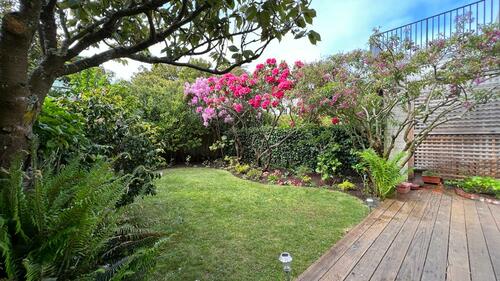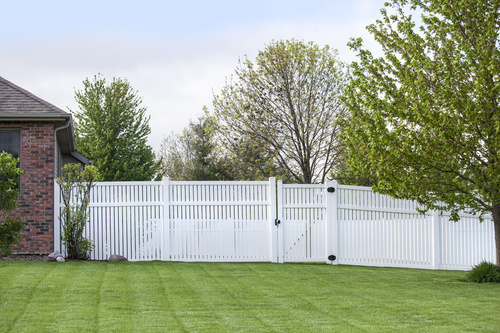How and Why You Should Landscape Around Your Fencing
Introduction
If you have installed fencing around your landscaping or have decorative fences in your backyard, you may be wondering what the next step is to perfecting your outdoor space. Should you landscape around the fences, or should they be left bare?
Let’s discuss the merits of landscaping around your fencing as well as several tasteful, easy ways to do it.
Why is it Important to Landscape Around Fences?

An Urban Backyard Fence Lined With Trees and Shrubs
Aesthetics
Landscaping around your fencing can be invaluable in creating a harmonious and appealing outdoor space that increases both the curb appeal and the enjoyment of your home. Experimenting with different landscaping themes allows you to tailor your yard to reflect your personal taste, whether you prefer a minimalist approach or a lush, vibrant feel. Even if you aren’t entirely sure what you want the “style” or theme of your property to be, adding some decorative plants, flower beds, or shrubs along your fencing can help you begin to grow your vision.
Adding a variety of decorative plants along your fencing can serve as the foundation for discovering and defining your home’s style. Choosing the right plants that are well-suited to your local climate, such as drought-resistant species, and arranging them strategically can add color and texture to an otherwise plain fence. Shrubs offer practical benefits too, providing extra privacy, reducing noise, and adding structure and texture. For an even more unique aesthetic, you can add climbing plants, flower boxes, or ivy to cover the actual fence as well.

Elegant Fencing Surrounded by Lush Landscaping
Softening Angles
Landscaping around fencing is a great way to soften the harsh lines and angles that fences often introduce into a yard, creating a more natural and aesthetically pleasing environment. Strategically placed plants, such as climbing vines, shrubs, and flowering plants, can transform a stark fence into a lush, green backdrop that enhances the beauty of your outdoor space. By selecting species that are well-suited to your local climate, you ensure that your garden is not only beautiful but also sustainable and low maintenance. This approach improves the visual appeal increases the biodiversity of the area, attracting birds and beneficial insects. Landscaping around fencing creates an environment that feels less urban and more natural and comfortable.
Integrating softscaping elements like tall grasses, perennial flowers, and small trees along the fence line also helps to blur the boundaries between different garden areas, promoting a sense of continuity and flow. This technique can be particularly effective in urban settings where outdoor space is limited, providing a sense of privacy while maximizing greenery. Landscaping around fencing can turn a functional boundary into a charming feature of your garden, boosting your property’s curb appeal and potentially its value. Employing the expertise of professional landscapers can ensure that the plant choices and placements perfectly complement your existing outdoor design and environmental conditions.
Tying Everything Together
Landscaping around fencing is great way to make a new fence fit in well with the rest of your landscaping. Rather than it simply looking like an afterthought, the added elements will tie everything together. By positioning plants, shrubs, and trees along the perimeter, you can create a cohesive look that flows naturally with the overall garden design. This integration helps to eliminate the visual disconnect often caused by stark fencing, blending the barriers with the surroundings. For example, using perennial beds or ornamental grasses along the fence line can soften the hard edges and extend the visual garden space, making the fence appear as an integral part of the landscape rather than an interruption.
For a cohesive look, consider the height and density of plantings to maintain balance and proportion in relation to the fence and the surrounding area. Tall shrubs or small trees can be used to add privacy and reduce noise without overshadowing shorter plants that add color and texture at eye level. This layering approach enhances the visual appeal of your fence and also supports a thriving ecosystem within the garden. Incorporating climbing plants like ivy or clematis can add vertical interest and draw the eye upward, further integrating the fence into your garden’s theme. Thoughtful landscaping around fencing is an important aspect in unifying your property’s aesthetic, enhancing both functionality and beauty in your outdoor living space.
Camouflage
Depending on the type of the fence that you have installed, you may want to use natural elements around it to soften or even camouflage it from view. For example, if you are using a chain-link fence for practical purposes, camouflaging it with climbing plants or tall, dense shrubs will make it much more pleasing to the eye. For even more visual appeal, you can utilize flowering climbers like clematis, honeysuckle, or jasmine to add aesthetic value and cover up the metal with vibrant blooms and foliage, making the fence both functional and attractive.
Landscaping along your fence can also camouflage unsightly views and enhance the privacy of your outdoor living spaces. By planting tall, dense shrubs or fast-growing trees along the perimeter, you can effectively block out undesirable sights, such as neighboring buildings or busy streets. Additionally, incorporating layers of varying heights with medium-sized bushes and colorful perennials adds depth and interest, diverting attention away from less appealing views. This method will help you create a more secluded and inviting atmosphere. Choosing plants that are well-suited for your local climate and soil conditions ensures that your privacy screen is both beautiful and low-maintenance, making it a sustainable choice for long-term enjoyment.
How Should I Landscape Around Fences?

A White Picket Fence Lined with Various Types of Flowers
When you decide to landscape around your fence, there are a few different aspects you should consider first.
Plant Needs and Requirements
As you choose plants, shrubs, and flowers to plant around your fence, consider their sunlight requirements to ensure healthy growth. Group plants that thrive in full sun in areas with western or southern exposure to take advantage of prolonged sunlight. This is ideal for sun-loving species such as roses, lavender, and hibiscus. For plants that prefer shaded conditions—such as ferns, hostas, and hydrangeas—position them in locations with eastern or northern exposure. This strategic placement according to light exposure will bolster plant health, enhancing the visual harmony and appeal of your garden. Additionally, to simplify your gardening efforts and ensure sustainability, it’s beneficial to group plants with similar watering needs together. This practice, known as hydrozoning, allows for more efficient water use and can significantly reduce maintenance time.
Fencing Type
When planning your landscaping along the fence, consider type of fence you have, as this will influence both the choice of plants and their placement. Fences made of wood or other materials that require periodic maintenance, such as painting or staining, will need to be factored in to your garden design. To ensure that you have easy access for these maintenance tasks, it’s wise to leave adequate space between the fence and your plantings. This allows for easier upkeep and helps prevent damage to the fence from moisture retention and plant growth, which can lead to rot or deterioration in wooden fences.
Spacing your shrubs and plants slightly away from the fence also promotes healthier plant growth by improving air circulation around the plants. This is particularly important for preventing fungal diseases and ensuring that plants receive sufficient light. Remember to consider the mature size of the plants, as overcrowding can compromise their health and the structural integrity of the fence. Opt for species that are resilient and can thrive in the microclimate created by your fence, whether it’s shaded or sunlit. Factoring these considerations into your landscape planning will enhance the longevity of both your fence and your garden.
Our Final Thoughts on Landscaping Around Fences

A White Wooden Fence in a Backyard
Landscaping around your fencing is not just a way to enhance the visual appeal of your outdoor space. It serves practical functions, such as increasing privacy and boosting property value. We hope this guide helps you with selecting the right plants and effectively positioning them to complement different types of fences. By choosing plants that are suited to your fence’s material and the surrounding environment and aesthetic, you can ensure the durability, beauty, and enjoyment of both your landscape and fence. No matter what style of fence you have or how you want to decorate it, using these tips can help make your outdoor space look incredible.
Previously published on January 17, 2019.


